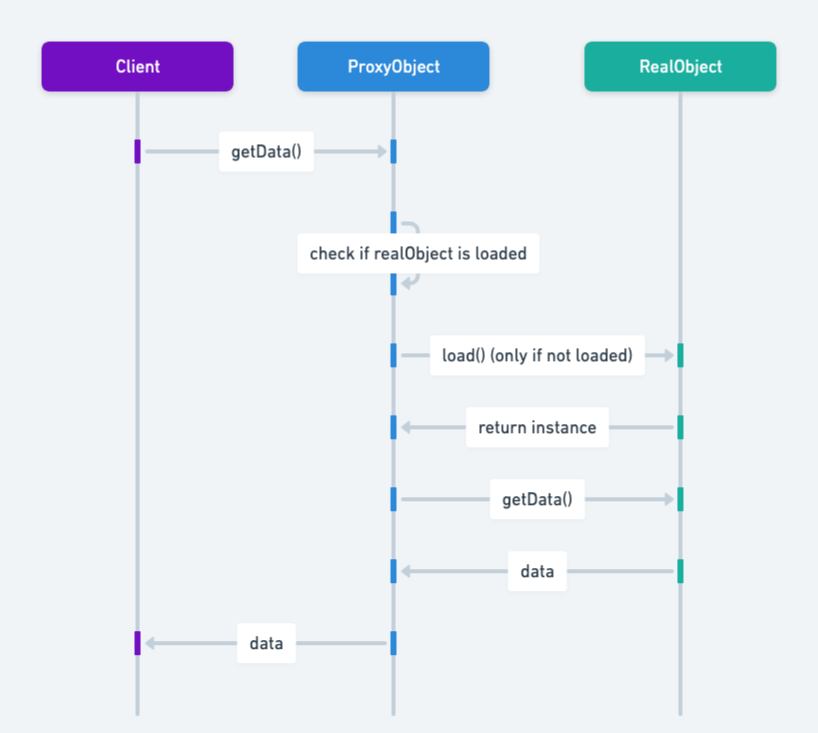Lazy Loading Pattern in Java: Enhancing Performance with On-Demand Object Initialization
Also known as
- Lazy Initialization
Intent of Lazy Loading Design Pattern
The Lazy Loading design pattern in Java defers object initialization until the object is actually needed, minimizing memory usage and reducing startup times. This technique is crucial for optimizing Java application performance.
Detailed Explanation of Lazy Loading Pattern with Real-World Examples
Real-world example
A real-world analogy for the Lazy Loading pattern in Java is using lights in a smart home. Instead of switching all lights on at once when someone enters the house, motion sensors detect and turn on lights only in rooms being used. This mirrors how Java developers can optimize performance by delaying object creation.
In plain words
The Lazy Loading pattern defers the creation of an object or resource until it's actually needed, optimizing memory usage and improving performance.
Wikipedia says
Lazy loading (also known as asynchronous loading) is a technique used in computer programming, especially web design and web development, to defer initialization of an object until it is needed. It can contribute to efficiency in the program's operation if properly and appropriately used. This makes it ideal in use cases where network content is accessed and initialization times are to be kept at a minimum, such as in the case of web pages. For example, deferring loading of images on a web page until they are needed for viewing can make the initial display of the web page faster. The opposite of lazy loading is eager loading.
Sequence diagram

Programmatic Example of Lazy Loading Pattern in Java
The Lazy Loading design pattern is a performance optimization technique that delays the initialization of an object or a costly computation until it's absolutely necessary. This pattern can significantly improve the performance of your application by avoiding unnecessary computation and reducing memory usage.
In the provided code, we can see an example of the Lazy Loading pattern in the App, HolderNaive, HolderThreadSafe, and Java8Holder classes.
The App class is the entry point of the application. It creates instances of HolderNaive, HolderThreadSafe, and Java8Holder, and retrieves the Heavy object from them.
@Slf4j
public class App {
public static void main(String[] args) {
var holderNaive = new HolderNaive();
var heavy = holderNaive.getHeavy();
LOGGER.info("heavy={}", heavy);
var holderThreadSafe = new HolderThreadSafe();
var another = holderThreadSafe.getHeavy();
LOGGER.info("another={}", another);
var java8Holder = new Java8Holder();
var next = java8Holder.getHeavy();
LOGGER.info("next={}", next);
}
}The HolderNaive, HolderThreadSafe, and Java8Holder classes are implementations of the Lazy Loading pattern with increasing sophistication.
The HolderNaive class is a simple, non-thread-safe implementation of the pattern.
public class HolderNaive {
private Heavy heavy;
public HolderNaive() {
LOGGER.info("HolderNaive created");
}
public Heavy getHeavy() {
if (heavy == null) {
heavy = new Heavy();
}
return heavy;
}
}The HolderThreadSafe class is a thread-safe implementation of the pattern, but with heavy synchronization on each access.
public class HolderThreadSafe {
private Heavy heavy;
public synchronized Heavy getHeavy() {
if (heavy == null) {
heavy = new Heavy();
}
return heavy;
}
}The Java8Holder class is the most efficient implementation of the pattern, utilizing Java 8 features.
public class Java8Holder {
private Supplier<Heavy> heavy = this::createAndCacheHeavy;
public Java8Holder() {
LOGGER.info("Java8Holder created");
}
public Heavy getHeavy() {
return heavy.get();
}
private synchronized Heavy createAndCacheHeavy() {
class HeavyFactory implements Supplier<Heavy> {
private final Heavy heavyInstance = new Heavy();
public Heavy get() {
return heavyInstance;
}
}
if (!(heavy instanceof HeavyFactory)) {
heavy = new HeavyFactory();
}
return heavy.get();
}
}In this example, the App class retrieves a Heavy object from HolderNaive, HolderThreadSafe, and Java8Holder. These classes delay the creation of the Heavy object until it's actually needed, demonstrating the Lazy Loading pattern.
When to Use the Lazy Loading Pattern in Java
Use Lazy Loading when:
- An object is resource-intensive to create and might not always be used.
- You need to delay object creation to optimize memory usage or improve startup times.
- Loading data or resources should happen just-in-time rather than at application startup.
Real-World Applications of Lazy Loading Pattern in Java
- Hibernate (Java ORM Framework): Delays loading of related objects until they are accessed, leveraging the Lazy Loading pattern to optimize Java application performance.
- JPA annotations @OneToOne, @OneToMany, @ManyToOne, @ManyToMany and fetch = FetchType.LAZY
- Spring Framework (Dependency Injection): Loads beans only when required, reducing application startup time.
Benefits and Trade-offs of Lazy Loading Pattern
Benefits:
- Reduces memory usage by initializing objects only when required.
- Improves application startup performance by postponing expensive object creation.
Trade-offs:
- Complexity in implementation if objects are interdependent.
- Risk of latency spikes if initialization occurs at an unexpected point.
Related Java Design Patterns
- Proxy: Can act as a placeholder for lazy-loaded objects, deferring their actual loading until necessary.
- Virtual Proxy: Specific type of Proxy that handles object creation on demand.
- Singleton: Often combined with Lazy Loading to ensure only one instance of an object is created and loaded lazily.